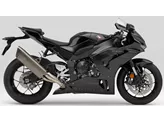Yamaha R1 2015 vs. Kawasaki Ninja ZX-10R 2016

Yamaha R1 2015

Kawasaki Ninja ZX-10R 2016
Overview - Yamaha R1 2015 vs Kawasaki Ninja ZX-10R 2016
The Yamaha R1 model year 2015 and the Kawasaki Ninja ZX-10R model year 2016 are both high-performance supersport motorcycles with similar technical specifications. However, there are some notable differences between the two.
In terms of engine and drive train, both motorcycles have a 998cc engine with four cylinders. The Yamaha R1 has a bore of 79mm and a stroke of 50.9mm, while the Kawasaki Ninja ZX-10R has a slightly smaller bore of 76mm and a larger stroke of 55mm. Both bikes have a compression ratio of 13, but the Yamaha R1 produces 200 horsepower and 112.4 Nm of torque, while the Kawasaki Ninja ZX-10R produces 200.1 horsepower and 114.3 Nm of torque.
In terms of suspension, both motorcycles feature upside-down telescopic forks at the front. The chassis of both bikes is made of aluminum, which provides a lightweight yet sturdy frame. Both motorcycles also have double disk brakes at the front, which offer excellent stopping power.

Yamaha R1 2015
In terms of dimensions and weights, both motorcycles have a front tire width of 120mm and a rear tire width of 190mm. The front and rear tire diameters are also the same at 17 inches. The Yamaha R1 has a wheelbase of 1405mm, while the Kawasaki Ninja ZX-10R has a slightly longer wheelbase of 1415mm. The seat height of the Yamaha R1 is 855mm, while the Kawasaki Ninja ZX-10R has a lower seat height of 813mm. Both motorcycles have a fuel tank capacity of 17 liters.
Now, let's move on to the strengths and weaknesses of each motorcycle. The Yamaha R1 2015 is known for its crazy sound and rev-happy engine with a strong peak. It provides a great racing feeling in the saddle and has a superior electronics package. The high-quality workmanship of the Yamaha R1 is also worth mentioning.
On the other hand, the Kawasaki Ninja ZX-10R 2016 has a great chassis geometry and high-quality chassis components. It also boasts very good brakes and has a wide range of electronics on board.

Kawasaki Ninja ZX-10R 2016
However, the Yamaha R1 2015 does have some weaknesses. It experiences torque sag in the middle, which can affect its performance. Additionally, stability in the braking zone may be a concern for some riders.
Similarly, the Kawasaki Ninja ZX-10R 2016 has a weakness in terms of cockpit readability. The cockpit may not be optimal for easy reading while riding.
In conclusion, both the Yamaha R1 2015 and the Kawasaki Ninja ZX-10R 2016 are powerful and capable supersport motorcycles. They have similar technical specifications but differ in terms of strengths and weaknesses. Ultimately, the choice between the two will depend on the rider's preferences and priorities.
Technical Specifications Yamaha R1 2015 compared to Kawasaki Ninja ZX-10R 2016
Pros and Cons in comparison
Pros and Cons in comparison
Yamaha R1 2015

The new R1 is a big hit and no longer compares to the previous model. This was considered a good country road bike and heavy investments had to be made for excursions to the race track. Now it is the other way round. The new R1 has been developed with a clear focus on the race track. The electronics package seems outstanding, technology freaks will get their money's worth. Yamaha fans have to buy it, they finally have a worthy motorbike. The R1 has slight weaknesses when braking - it becomes a little unstable here. If you want to buy a ready-made racing bike without having to work on the chassis, you'd better go for the R1M. The Öhlins electronic suspension works perfectly and has no weaknesses. For pure racetrack use, the second weakness of the R1 can easily be ironed out. The torque hole in the middle can be easily ironed out with a new mapping.
Kawasaki Ninja ZX-10R 2016

The ZX-10R Ninja has a certain majesty, at the first rollout it seems very stable, you have to force it into the radius a little. After a few laps, however, this effect is transformed into an incredible precision that allows a pinpoint line. The engine has now really become noticeably stronger and makes the Kawa an enormously good overall package that can please not only die-hard Kawasaki fans. The traction control on the Kawa is particularly positive and regulates very sensitively. You can even adjust the engine brake - so it certainly doesn't lack for electronic features. The ZX-10R is the only superbike that is already Euro4-compliant in 2016!
Price Comparison Avarage Market Price Yamaha R1 vs Kawasaki Ninja ZX-10R
There are a few key differences between a Yamaha R1 2015 and a Kawasaki Ninja ZX-10R 2016. It takes less time to sell a Yamaha R1 with 76 days compared to 100 days for a Kawasaki Ninja ZX-10R. Since model year 2005 1000PS.de editors have written 80 reviews for the Yamaha R1 and 51 reviews for the Kawasaki Ninja ZX-10R since model year 2005. The first review for the Yamaha R1 was published on 28/04/2003 and now has more than 3,900 views. This compares to more than 2,900 views for the first review on Kawasaki Ninja ZX-10R published on 11/01/2004.






















